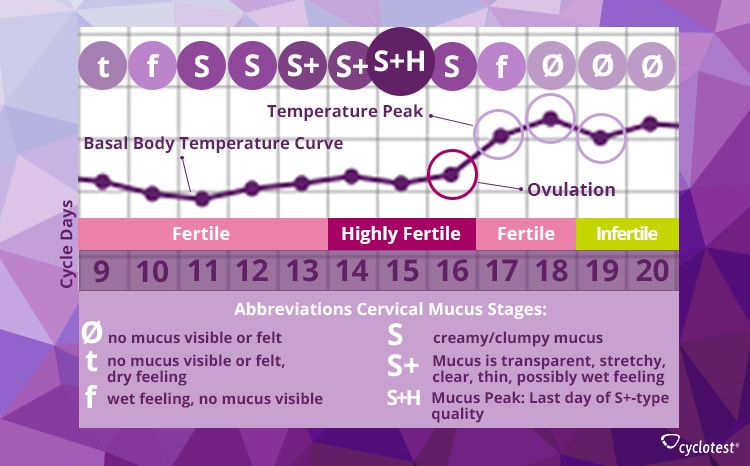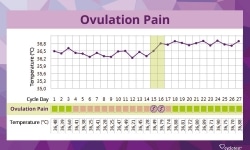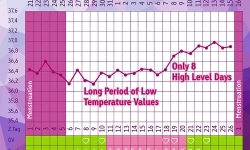Was Du auf dieser Seite findest:
What’s Cervical Mucus?
Cervical mucus is the discharge that you can see in your underwear. It is produced by glands within the cervix and provides sperm transport as well as prevents germs from entering the vagina. Cervical mucus is a sign of ovulation, which changes over the course of a cycle, thus giving information on a woman’s fertility. During the infertile phase, the thick discharge blocks sperms from wandering upwards. The mucus becomes more liquid during the fertile phase, facilitating the sperms’ journey to the uterus and increasing the chance of becoming pregnant.1
What are the Stages of Cervical Mucus within a cycle?
The cervical fluid changes in appearance and quality due to hormonal fluctuations during the menstrual cycle. The quality and amount is influenced by oestrogen and progesterone. The variations indicate precisely, in which cycle phase you are currently and when ovulation can be expected.
Cervical Mucus after Menstruation
At the beginning of a cycle after menstruation most women either notice little or no discharge. Some women even have a dry, uncomfortable feeling shortly after their period. A few days after, a wet feeling down there is common. For some women, mucus becomes now visible and they can feel it. The discharge during that time is usually yellowish or whitish and its consistency is creamy, thick and often even clumpy and sticky.2

Cervical Mucus before Ovulation
The closer you get to ovulation, the clearer, thinner and more transparent mucus gets at the cervix. This change is caused by the elevated production of oestrogen by the glands of the cervix. The entrance of the vagina now feels wet, slippery and moist. The fluid is stretchy and looks like raw egg white. The quality of cervical discharge is the best when you are ovulating. It is now particularly easy for sperms to travel to the uterus, and the chances of getting pregnant are the highest. If you wish to have a baby, it is now the best time to have sex.2
The next picture shows cervical mucus that looks like egg white. It indicates that you are fertile. It is possible to stretch it up to 5 centimetres without tearing. This is called “Spinnbarkeit” – German for spinnability. Around ovulation, the fluid becomes more watery and thinner and you feel wet down there. Under the microscope, the so-called fern phenomenon, crystallized salt, becomes visible.
Cervical mucus after Ovulation
The quality of cervical mucus deteriorates, i.e. it becomes intransparent, sticky and is no longer stretchy. The colour changes again, too, and it becomes yellowish or whitish. Sometimes it disappears entirely. There are ususally no changes of the mucus until the period sets in again.2
Cervical Mucus without Natural Cycle
Women who use hormonal contraceptives like the birth control pill often do not have discharge and do not notice any change during the menstrual cycle. The reason for that is that the production of cervical fluid is connected to the natural hormonal processes of a woman.2
Cervical Mucus during Pregnancy
Hormonal fluctuations during pregnancy cause the consistency of the cervical mucus after fertilization to change. Some women notice an increased mucus production and a milky, thin consistency. However, not all women observe a change during pregnancy. It is common that neither an increase nor a decline in cervical mucus occurs after nidation.
The production of cervical mucus is likely to increase weeks or days before giving birth as the cervix dilates. Right before giving birth, the cervical fluid might be reddish due to bursted blood vessels.3
Distinguishing Cervical Mucus
Don’t confuse arousal fluid with regular cervical fluid. The consistency of arousal fluid is similar to stretchy cervical mucus – clear and stretchy. If you are aroused, the evaluation of the fluid is not reliable. If you are not sure what kind of fluid you are dealing with, you can dissolve it in water. Arousal fluid dissolves while regular discharge doesn’t.
Abnormal discharge can be a sign of an illness. It is then accompanied by a strong odour, itching or a burning sensation.
How to Observe Cervical Mucus
Cervical mucus can be felt or seen. Both ways of observation are important when recording your cervical mucus. You can check the quality of the cervical discharge by taking a sample with toilet paper, folding the paper and, while unfolding it, checking the consistency before actually going to the toilet. You can check the quality with your fingers as well by inserting two fingers in your vagina.2
Stages Cervical Mucus
Cervical mucus can be classified into different stages. According to the methods of Natural Family Planning (NFP) there are certain abbreviations making the analysis of mucus easier. These are the abbreviations for the respective type:
Abbreviation Ø
No mucus seen or felt, no wet feeling, no mucus visible.
Abbreviation t
No mucus seen, dry feeling, no mucus visible, sometimes itchy or uncomforable feeling.
Abbreviation f
Wet feeling, no mucus visible.
Abbreviation S
Mucus is thick, whitish or yellowish, clumpy or creamy, wet feeling or no feeling.
Abbreviation S+
Mucus is watery, transparent, stretchy, like egg white, maybe reddish, thin, clear, wet feeling, vagina feels slippery or no feeling.
Abbreviation S+H
The last of day the best cervical mucus quality (type S+) before the quality deteriorates. It can only be detected afterwards. It is called cervical mucus peak.
Which Cervical Mucus Quality should I Use?
Cervical mucus can change throughout the day. It is important to note down the result for each day in the evening and to choose the best quality you detected on that day.
Recording cervical mucus can be challenging in the beginning. Make sure you always write down exactly what you observe, even though it differs from what you detected in the past cycle.
How to Evaluate Cervical Mucus
In order to be able to evaluate your cervical mucus records and to determine your fertile days, it is necessary to identify your cervical mucus peak. This peak can only be detected afterwards as it is the last day of the best mucus quality.
Cervical Mucus Peak
If you observed the best mucus quality S+ for 3 days and then, on day 4, the quality deteriorates, day 3 should be marked as the cervical mucus peak S+H.
The following chart reflects the connection between the different consistencies of cervical fluid, the temperature as well as the day of ovulation. In this example, you can see that the best mucus quality was detected on the 15th cycle day. This was the 3rd day of the type S+.

Cervical Mucus Quality Fertile
However, a mucus peak can only be confirmed if the quality is worse for 3 days in a row. The chart demonstrates this: A deteriorated quality (S, f and Ø) was detected for 3 days after S+H. According to this example, the infertile phase begins on day 19. By evaluating your discharge every month, you will become more secure in determining your fertile phase.
The cervical mucus peak is identified on the last day of the most sperm-friendly quality. What does that mean for your observation? It is actually pretty simple: It is the best cervical mucus quality you can detect within a cycle. The most important thing is that you are able to recognize the change to a quality less friendly to sperm and that it is worse for 3 days in succession.
Type t and ø are insignificant to couples who want to get pregnant. Type f mucus can be a sign of fertility. S and S+ are good mucus qualities which promote a pregnancy. The cervical mucus peak (S+H) is the most fertile day. If you are planning a child, you should have sex on that day.
Cervical Mucus and Ovulation
As every woman experiences changes in the course of the menstrual cycle, it is possible to draw conclusions from cervical mucus observations to ovulation. Due to the changes in the oestrogen level, the consistency of the cervical mucus varies, enabling semen to wander quicker when your are ovulating. It takes place between 2 days before and 2 days after the cervical mucus peak.
Tips on Observing and Analysing Cervical Mucus
We would like to provide you with some tips and tricks so that you are well prepared to evaluate your cervical mucus. We also took expert advice from gynecologist Prof. Dr. Ingrid Gerhard.
How Often and When Do I need to Observe my Cervical Mucus?
We recommend observing your discharge on a daily basis in the beginning. The consistency can also change in the course of a day. You always have to record the best quality of the day. It is best to check the mucus before urinating. Otherwise the mucus might be gone.
The cyclotest fertility monitors, which can determine your fertile phase by recording and analysing your waking temperature, enable you to enter your cervical mucus observations. Thus, fertility can be identified more precisely. Our fertility computers can either assist you with a natural way of contraception or if you would like to get pregnant at a desired date by identifying the most fertile days.
How Reliable is Cervical Mucus Observation?
Many women are wondering whether they are able to categrorise the fluid that is released from the cervix correctly and if their observation conforms with physiological data. We asked advice from a gynaecologist and asked her if, according to her experience, it is easy for most women to monitor their fluid.
Prof. Dr. Ingrid Gerhard, Specialist in Gynaecology, replies:

For women with a regular cycle, it is usually easy to monitor their discharge. However, every woman needs some time to find out, when and for how long a certain mucus type is present. It is important to combine the method with the basal body temperature method and to carefully record the mucus quality.
There are a number of international studies on the validity of cervical mucus observation. A German study investigated how the individual identification of the ovulation date by monitoring the discharge was identical to the actual ovulation date. The result was that the cervical mucus peak was determined on the ovulating date identified medically or one day before or after in 82% of all cycles.4
Another study concluded that the peak coincided in 3 to 4 cycles with the actual ovulation date or one day before or after.5 The WHO also carried out a study on this subject. The result was that the identified mucus peak was 0.3 days after the actual LH peak, i.e. the day with the highest level of the hormone LH.6 The findings of the studies show that self-monitoring is reliable and useful.
However, monitoring your cervical mucus only is not reliable enough. You should always apply it in combination with Natural Family Planning by exercising the temperature method as well. If you are planning a child, the mucus method solely can be helpful in determining your fertile days.
Applying it in combination with the basal body temperature method it is called symptothermal method and considered the safest natural contraceptive method. It is also very useful if you would like to realise your dream of having a child.2
Can I Improve the Quality of Cervical Mucus?
You should know that it is possible to improve your cervical mucus quality. This is particularly useful for women who would like to become pregnant. It is helpful to drink a lot of water or herbal tea so that your mucus becomes more permeable and liquid. Your diet plays a decisive role too: Products with a lot of B vitamins increase the supply of good mucus quality. Foods which contain B vitamins are broccoli, spinach, green cabbage, Brussels sprouts, endive, yeast, tomatoes, oranges.7 A mucolytic cough mixture can have the same effect. It is therefore often prescribed during a fertility treatment.1
We also asked Prof. Dr. Gerhard if there were any ways to improve the quality of cervical discharge by your eating habits.
Prof. Dr. Ingrid Gerhard, Specialist in Gynaecology replied:
he better oogenesis is, i.e. the more oestrogen is produced in the ovaries by a follicle, the easier it is to evaluate the consistency of the mucus. The higher the oestrogen production, the clearer and stretchier the fluid becomes. A healthy diet with a lot of natural nutrients promotes a healthy cycle and oogenesis. The production of hormones depends on a sufficient supply of vitamins, mineral nutrients, micronutrients and phytochemicals. Overweight as well as underweight are counterproductive. An organic vegetable diet with a lot of fruits and wholemeal grains and little meat, sausages and dairy products are recommendable. The hormones in dairy products and meat might disturb your hormonal balance.
Did I Choose the Correct Mucus Type?
The changes of cervical mucus are different form woman to woman. Some women only notice it when they are ovulating, others feel and see discharge during their entire menstrual cycle and detect different phases from dry to wet or clumpy to clear and stretchy. However, a change to a less fertile mucus quality after ovulation can be identified by most women.2
Sometimes it happens that there is no clear difference between the types S and S+ and classifying it is not really possible as the change is hardly noticeable. A slight change to a lower quality can then be marked as the last day of the best quality and cervical mucus peak. This special rule may only be applied if it happens for several cycles in a row.2
Checking your discharge needs practising and requires patience, especially in the beginning. Make sure you obtain detailed information on the method. Basic knowledge on the different types of mucus are essential.
Quantity: Not Enough Mucus or Too Much
If there is not enough fluid you feel rather dry, check if there are any changes in the middle of your cycle. Examine your mucus daily, for example with toilet tissue. It is enough if you can determine good sperm-friendly quality once within a cycle. Instead of getting a sample from the entrance of the vagina, you can also get one directly from the cervix. For this purpose, introduce one finger 8 to 9 cm, then examine the mucus.
If there is loads of mucus and you hardly notice a difference between type S and S+ mucus, within-class grouping might help: Compare all days with a good mucus quality and mark the “best” days with S+. There might be something wrong with your discharge if your feel wet right after menstruation or after ovulation. You should then get it checked by a doctor.
If you find it difficult to examine and/or analyse your cervical mucus, observing the location of your cervix might be another option in order to determine your fertile days.
The Beginnings of the Cervical Mucus Method
The first time mucus was considered a symptom and mentioned in a system of rules for family planning was in the 1950s by neurologist John Billings and doctor Josef Rötzer, who worked independently from one another. The method developed by Billings is also called “Ovulation Method” and it included the basal body temperature as well. Later, he specialized only in the mucus method, which is also known as the “Billings Ovulation Method”. Apart from the basal body temperature, cervical mucus is the most important indicator for fertility because. Unlike other fertility signals, it can be monitored regularly and observed objectively.1
Advantages of Cervical Mucus Observation
Checking your mucus consistency on a daily basis allows you to draw conclusions on the start of your fertile phase before ovulation. Other symptoms cannot assist you in determining your fertile phase in the first half of your cycle. Identifying the LH by carrying out an ovulation test, for example, helps you to define the approximate ovulating but the end of the fertile phase after your period can only be identified afterwards.1 Another advantage of monitoring your cervical mucus is that it is free. There is no need to buy any equipment or tests to measure your hormone level. Furthermore, many women worship that they now have to deal with their individual menstrual cycle and are positively surprised, how much they can learn from monitoring different symptoms and signals about their bodies and themselves.
Cervical Mucus as Fertility Symptom
Cervical mucus is a useful indicator for fertility and is considered a reliable fertility symptom. The fertile phase starts when the quality of your mucus improves. The fluid protects the sperms and keeps them functioning. The infertile phase begins 3 days after the cervical mucus peak. By monitoring the cervical mucus stages for several months, you can learn to notice changes and to determine your fertile days.
If you would like to realise your dream of having a baby soon, observing and evaluating your discharge can help you. If you are currently on the pill and are looking for a natural way to prevent a pregnancy, you should try going off the pill and combining the mucus method with the analysis of the body temperature.
Sources:
1 Raith-Paula, E. et al.: Natürliche Familienplanung heute. Modernes Zykluswissen für Beratung und Anwendung. 5th edition. Heidelberg 2013.
2 Malteser Arbeitsgruppe NFP (Hrsg.): Natürlich und sicher. Das Praxisbuch. 18th edition. Stuttgart 2011.
3 Murkoff, H.: Schwangerschaft und Geburt: Alles, was Sie wissen müssen. 1st edition. Munich 2012.
4 Gnoth, C. et al.: Wie korrelieren selbstbeobachtete Zyklussymptome mit der Ovulation? Zentralbl Gynäkol, 118: 650-654. 1996.
5 Ecochard et al.: Chronoligical aspects of ultrasonic, hormonal, and other indirect indices of ovulation. BJOG. 108: 822-829. 2001.
6 World Health Organization: Temporal relationship between indices of the fertile period. Fertil Steril. 39: 647-655. 1983.
7 Gnoth, C. et al.: Kinderwunsch. Natürliche Wege zum Wunschkind. 3rd edition. Munich 2009.






